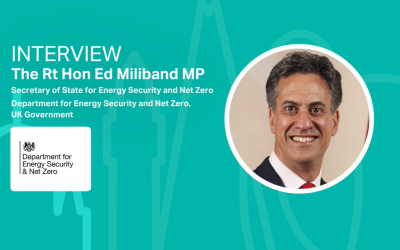Building Resilient Portfolios: Matt Eby on Physical Climate Risk and Investor Strategy
Matt Eby, CEO and Founder of First Street, spoke to Climate Action about how physical climate risks are reshaping investment strategies. He emphasised that understanding these risks is no longer optional—it is a critical part of protecting and growing portfolios. From floods to wildfires, investors must recognise how environmental changes directly influence financial outcomes. In this Q&A, Eby shares insights on integrating resilience into lending, portfolio management, and strategic planning.

1. What is physical climate risk, and why does it matter for investors?
Physical climate risk describes the measurable impact that environmental conditions have on the value and performance of assets. It can be the flooding of a manufacturing site, a wildfire closing a logistics corridor, or extreme heat driving energy costs higher or straining infrastructure. These events are no longer isolated shocks—they are a part of the operating environment. With evolving disclosure rules and financial regulations worldwide, investors are being asked to better understand how physical risks affect their portfolios.
For investors, this matters because it changes how risk accumulates and how value erodes. Traditional financial analysis captures credit, liquidity, and market exposure, but not the physical systems those depend on. When these systems fail or shift, the financial consequences ripple through portfolios in ways most models were never built to anticipate.
These exposures are becoming visible in ways they weren’t before, influencing insurance markets, asset valuations, and even the cost of capital. For investors, understanding this isn’t about predicting catastrophe; it’s about recognising how the physical world directly drives financial outcomes today.
2. How should investors be thinking about climate risk? How do we integrate climate resilience into lending and investment plans?
Most investors only notice climate risk once it has already affected their holdings, but it is a hidden cost embedded in every balance sheet. It appears through rising insurance costs, impairment charges, or supply chain interruptions. In 2001, 17% of publicly traded U.S. companies cited potential weather disasters as a material risk; today, that number has grown to 65%. More than half of companies now report climate and extreme weather as a material business risk.
Traditional risk models assume environmental conditions are stable. As severe natural disasters become more common, that assumption no longer holds, meaning portfolios carry exposures invisible in most current valuation methods.
The shift underway treats climate risk as a measurable financial variable. Understanding how hazards—like flooding, wildfire, and extreme heat—affect operating costs, asset values, and the availability of insurance or financing allows resilience to be priced and managed rather than discussed abstractly.
Integrating this perspective requires the same discipline used for credit or market risk: consistent data, actionable metrics, and broader economic context. Regulatory momentum behind climate disclosure and stress testing reinforces this discipline, making resilience part of standard due diligence. The goal is not to avoid risky regions or sectors, but to identify where adaptation improves long-term performance. When resilience is embedded in underwriting, asset management, and portfolio strategy, it protects returns and fosters more stable growth over time.
3. There’s a lot of information about climate risk already out there. How do we navigate the complexity and variety of available data?
Investors today have more climate data than ever, yet much of it looks backward. Historical loss records describe what has happened, not what is likely to occur. The challenge is distinguishing data that informs future action from data that only illustrates the past.
The starting point is the physical world itself. At First Street, we build in-house models simulating how water, wind, or fire behave at specific locations to identify where exposure truly lies. Probabilities are then translated into financial metrics, like expected loss or downtime, making them directly relevant to portfolio and credit analysis.
Investors should prioritise transparency and consistency over novelty. The best data sources explain their methodology and allow comparison across geographies, hazards, and asset types. Using a single, coherent framework to assess multiple perils reduces noise and aligns internal teams that might otherwise rely on conflicting inputs.
Clarity does not come from having more data, but from connecting the right data to the right financial questions. Understanding where numbers come from, what they measure, and how they influence value turns information into strategy.
4. What’s the upside? How are we able to build portfolios that withstand systemic shocks and still find opportunity?
Assessing physical risk is not only about limiting downside—it also reveals where adaptation, infrastructure investment, and innovation create value. Investors who understand which regions, industries, or assets remain functional under stress can allocate capital toward them before the broader market recognises their advantage.
Scenario analysis and stress testing identify where operating costs or insurance burdens are likely to rise and where improvements—like flood protection, cooling efficiency, or diversified logistics—already provide an edge. These insights inform defensive moves, such as reducing concentration in vulnerable areas, and proactive ones, like increasing exposure to resilient supply chains or critical infrastructure.
The financial upside of resilience is gradual but compounding. Portfolios anticipating and adjusting to physical realities experience fewer sudden losses, steadier returns, and stronger long-term credibility with clients, regulators, and policymakers. As climate policy evolves, investors integrating these insights will be best positioned to shape, not just follow, the next standard for resilient, data-driven markets.
List of All Changes Made
1. Added a 4-sentence introduction starting with “Matt Eby, CEO and Founder of First Street, spoke to climate actions about…” to frame the article.
2. Created an engaging, professional article title emphasising resilience and investor strategy.
3. Streamlined sentence structure to improve readability and flow, breaking long sentences into concise, digestible parts.
4. Clarified technical terms and examples (e.g., “flooding of a manufacturing site, wildfire closing a logistics corridor”) for reader comprehension.
5. Standardised capitalisation, punctuation, and formatting in headings and throughout the text for a polished, publication-ready style.
6. Improved logical flow by reorganizing paragraphs to move from problem → impact → solution.
7. Simplified repetitive phrases and tightened language (e.g., “they are a part of the operating environment, and as new disclosure rules…” → “they are a part of the operating environment. With evolving disclosure rules…”).
8. Refined tone to be media- and investor-friendly, balancing professional authority with accessible language (e.g., “not optional—it is a critical part” vs. “that matters because”).
9. Enhanced emphasis on financial relevance by linking physical risks directly to portfolio outcomes throughout.
10. Ensured consistency in metric and data discussion, highlighting First Street’s methodology and the practical use of climate data.






